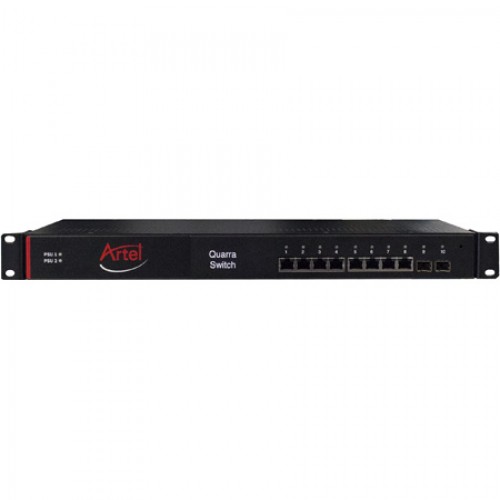Artel 2800-EQ219-BOM 1G Ethernet Switch ARG10100 QUARRA PTP Switch
- Brands Artel Video Systems
- Product Code: ARTL-2800EQ219BM
- Availability: In Stock
-
$2,595.00
The ARG Quarra range of switches is designed for carrier class applications where accurate timing and control is required. These switches are aimed at the professional markets of audio/video broadcast, defense and security, finance, utilities, telecom and enterprise IT.
Designed as either a standard 1RU rackmount unit with dual power supplies, or a half-width 1RU unit with a single power supply, the switches are available in several configurations of Gigabit and 10 Gigabit interfaces supporting a best in class layer 2 IEEE 1588v2 algorithm. A 1pps external reference input from GPS is included as standard and options include an internal layer 1 Synchronous Ethernet module.
The ARG Quarra switches support IGMP v2/3, QoS, Protection switching, VLAN, MEF service delivery, and network OAM.
Features:
- SMPTE ST 2059-2 & ST 2110-10 Ethernet Switching
- RAVENNA AES67 Ethernet Switching
- Industry's most Accurate IEEE 1588 Timing & Synchronization for nanosecond accurate timing
- Synchronous (L1) Ethernet, Master, and Slave. Precision clock timing using DSPLL technology
- 1pps reference. Network wide synchronization using IEEE1588 or SyncE
- SMPTE Standards-based Timing: ST 2110-10 System Timing and Definition; ST 2059-2 SMPTE Profile for Use of IEEE-1588 Precision Time Protocol in Professional Broadcast Applications
- RAVENNA AES67 approved
- IEEE802.1 AVB
- Full management from Web GUI or command line interface. No training required-units can be quickly and easily configured
- Live Video/Audio broadcast/production over IP utilizing IEEE 1588 timing, QoS, and Multicast filtering
- Broadcast DTT/DTV IP distribution, utilizing IEEE 1588 and SyncE timing to replace or backup GPS timing at base stations
- Telecoms networks, providing high level of network timing
- Financial/trading networks, utilizing our IEEE1588 precise nanosecond time synchronization
Specifications:
-
Carrier Ethernet
- Layer-2 IEEE 1588v2 : Precision Time Protocol (PTP) timing and synchronization
- IEEE 802.1ad : Provider bridging (VLAN Q-in-Q) switch - 8 MACs, 4K VLANs
- Per queue MEF E-LINE or per port MEF E-LAN, E-TREEService Points - Per port per queue Dual Leaky Bucket Service Policers with PCP or DSCP remarking per Service port- Static tagging options per Service Point
- OAM Hardware for generating CCM messages, CCM checking is done by software - Software of OAM and protection switching
- EPS and ERPS Protection Switching
- TCAM-based VLAN classification and translation with pattern matching against Layer-2 through Layer-4 information
- Up to 256 QoS and VLAN TCAM entries
- Eight QoS queues per port with strict or deficit weighted round-robin scheduling (DWRR)
- DSCP translation, both ingress and/or egress
- DSCP remarking based on QoS and VLAN TCAM entries
- VLAN (PCP, DEI and VID) translation, both ingress and egress
- Per-queue, per-port policing and shaping, programmable in steps of 100 kbps
- Per-flow policing through TCAM-based pattern matching, Up to 256 policers
- Full-duplex flow control (IEEE 802.3x) and half-duplex backpressure, symmetric and asymmetric
Layer 2 Switch - Port mirroring
- Port-based access control
- IEEE 802.3ad: Link aggregation
- IEEE 802.1x: Network Access Control
- IEEE 802.1w: Rapid Spanning Tree Protocol
- IEEE 802.1s: Multiple Spanning Tree Protocol
- Simple Network Management Protocol (SNMP)
- Independent and shared VLAN learning
- 256 VLAN egress tagging TCAM entries
- Link aggregation traffic distribution is programmable and based on Layer-2 through Layer-4 information
- Basic Switching - Forwarding, address learning and address aging
- VLAN IEEE 802.1Q (4,096 VLAN's) - Push / pop / translate up to two VLAN tags; translation in ingress and / or egress
- 8,192 MAC addresses. Including Generic Attribute Registration Protocol (GARP)
- Wire-speed hardware-based learning and CPU-based learning configurable per port
Multicast - 8K Layer-2 Multicast group addresses with 64 port masks
- 8K IPv4/IPv6 multicast groups
- Internet Group Management Protocol v2 & v3
- Multicast Listener Discovery (MLDv1)
- Multicast Listener Discovery (MLDv2) with source specific multicast forwarding
Quality of Service
#web-mk>

